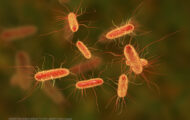Colonies of glowing E. coli can be used as living, low-cost biosensors, scientists at the University of California San Diego (UCSD) have discovered.
Bacteria such as E. coli are sensitive to environmental pollutants,. So would equipping them with the ability to glow allow the scientists to see their reactions? UCSD scientists decided to find out.
Using a bioengineering process, UCSD scientists attached a fluorescent protein to some E. coli and synchronized the colony to blink on and off in unison like a flashing neon sign. When the blinking colony detected low levels of arsenic, it slowed its rate of flashing.
UCSD scientists believe this technology can be used to create living, low cost biosensors that can detect pollutants and pathogens.
“These kinds of living sensors are intriguing as they can serve to continuously monitor a given sample over long periods of time, whereas most detection kits are used for a one-time measurement,” Jeff Hasty, a professor of biology and bioengineering at UC San Diego who headed the research team, said in a statement. “Because the bacteria respond in different ways to different concentrations by varying the frequency of their blinking pattern, they can provide a continual update on how dangerous a toxin or pathogen is at any one time.”




